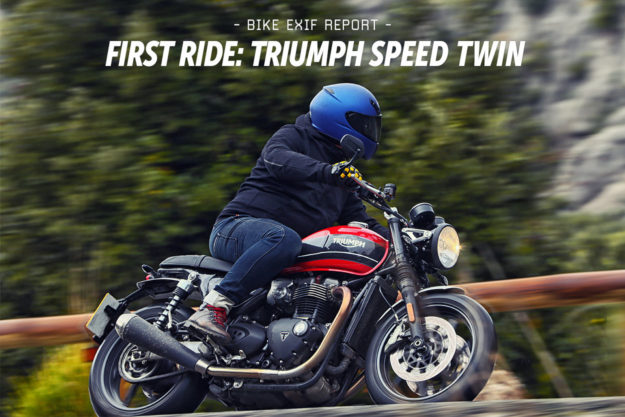
Most manufacturers have at least a couple of retro-styled motorcycles on sale. But Triumph has more skin in that game than anyone else: Hinckley’s modern classics outnumber their other models by a significant margin.
The new Speed Twin adds yet another name to the roster. So is the range too crowded now, or is the Speed Twin different enough to be significant? I headed to the usually sunny Mediterranean island of Mallorca to find out.

The Speed Twin gets its name from the groundbreaking parallel twin that Edward Turner designed [above] back in 1938. But it has far more in common with its current siblings. Think of it as a beefed-up Street Twin; or as a Bonneville with the Thruxton’s performance mindset, sans the café racer styling and ergonomics.
I’ll admit to initially dismissing the Speed Twin as a pointless in-betweener. But as a performance roadster, it actually has a lot going for it.

It’s powered by the ‘High Power’ version of Triumph’s 1,200 cc Bonneville parallel twin motor, with the same tune and compression ratio (11.0:1) as the Thruxton. But Triumph did more than just transplant the Thruxton mill.
There’s a new low-inertia crank and high-compression head. Plus a magnesium cam cover, a new clutch assembly, and ‘mass optimized’ engine covers (basically, they’re lighter). Combined, it makes for a 2.5 kilo (5.5 lbs) weight saving on the motor alone.

Output is the same as the Thruxton R—96 hp and 112 Nm—but it’s how it makes those numbers that’s notable. The torque curve on Triumph’s dyno chart is a thing of beauty. Peak torque is made at 4,950 rpm, but 90 percent of that is already in your hands by 2,500 rpm.
Traction control comes standard (and can be deactivated), along with three selectable riding modes: Sport, Road and Rain. The Speed Twin also features a six-speed box, and Triumph’s easy-to-use ‘Torque Assist’ clutch system. And it only needs its first service at 10,000 miles (16,000 km).
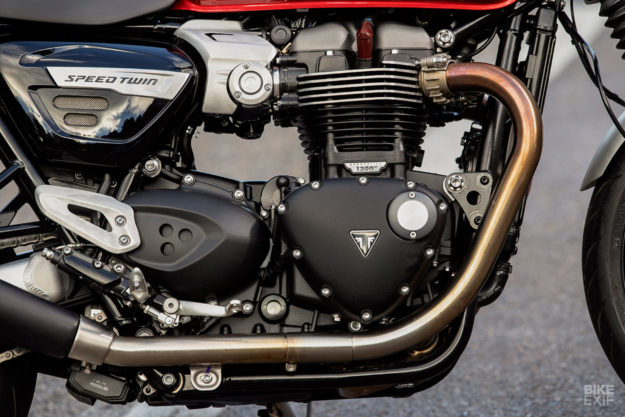
Weight is 196 kg (432 lbs) dry—ten kilos less than the Thruxton, and seven less than the Thruxton R. That’s helped by parts like the new cast aluminum wheels, aluminum frame cradles, an aluminum swing arm, and a lighter battery.
The chassis itself is an adapted version of the Thruxton’s, but with revised geometry. Triumph have stretched it out, with a longer wheelbase, a hair more rake and a few millimeters more trail.
Suspension is KYB all around, with non-adjustable 41 mm right-side-up forks, and preload-adjustable twin rear shocks. When quizzed as to why they didn’t spec the Speed Twin with adjustable suspension, Triumph put it down to cost saving.

They also assured me that the stock suspension would be up to the task, and pointed out that very few customers actually tune their suspension (which, to be fair, is very true). And when I asked if we could look forward to a Speed Twin R with upgraded suspension, they dodged the question. (So I’m betting we can.)
Braking is via twin Brembo four-piston calipers up front, and a single Nissin two-piston caliper at the back, with ABS included. The wheels measure 17×3.5 front and 17×5.0 back, and the Speed Twin comes from the factory with aggressive Pirelli Diablo Rosso 3 tires.
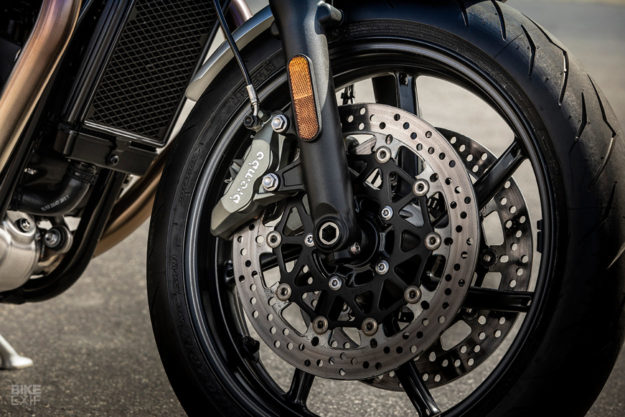
That’s a decidedly modern tire choice for such a classically styled motorcycle, but it’s this blend of old and new that defines the Speed Twin’s styling…and attitude.
It clearly shares DNA with the handsome Bonneville T120—but its stance is way more muscular and aggressive. The two bikes actually use the same 14.5 l fuel tank design, but the Speed Twin has revised mounts to alter its angle.
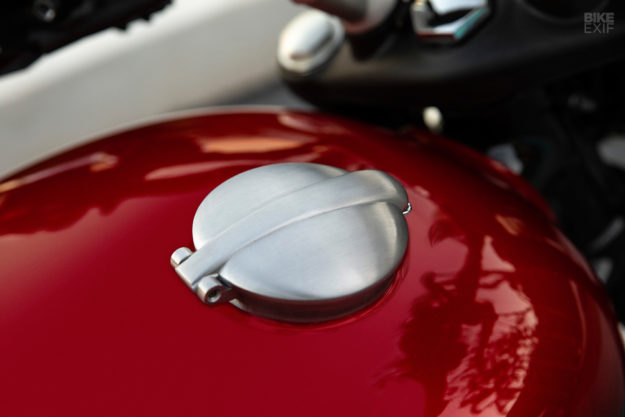
Items like the twin analogue/digital clocks, stylish Monza-style gas cap and twin upswept exhausts add to the old-school charm. But they’re offset by contemporary design touches, like alloy wheels, an LED daytime running light in the headlight, and a slim LED taillight and turn signals.
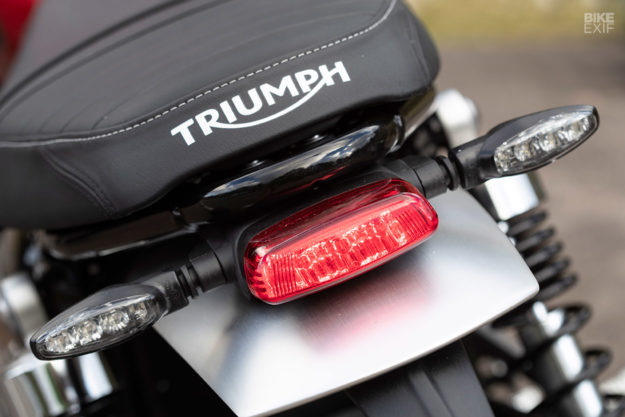
The complete package is damn good looking—and that’s not trick photography either. Seeing the Speed Twin in person gave me plenty of time to pore over the finer details, of which there are many. I noted the short, aluminum fenders, the bar end mirrors, and the extra trim on the side covers and throttle bodies; none of those are optional extras.
And yes, there’s a full complement of add-ons available too. Triumph had a parts display bike there, with kit such as brushed Vance & Hines mufflers [below], alternative seats and minor trim parts.
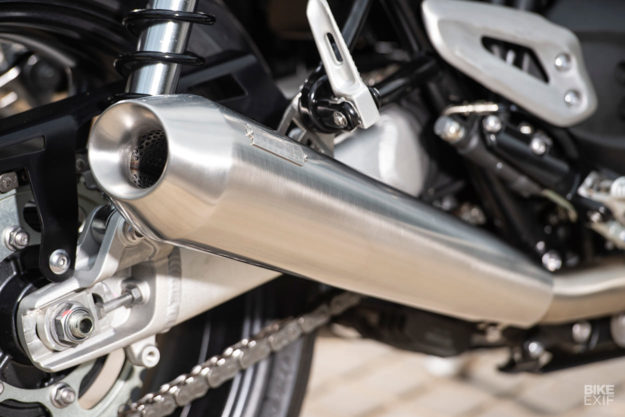
What’s more, Triumph has knocked the build quality right out of the park. Everything feels solid to the touch, with very little plastic in sight. And despite the fact that the Twin is liquid-cooled and packed with modern tech, there’s refreshingly little wiring or plumbing in sight.
I do have one gripe though. For all of the consideration that clearly went into the Speed Twin’s design, the junction between the rear frame, taillight and fender feels like an afterthought. Still, that’s about the only styling fault I could nitpick.
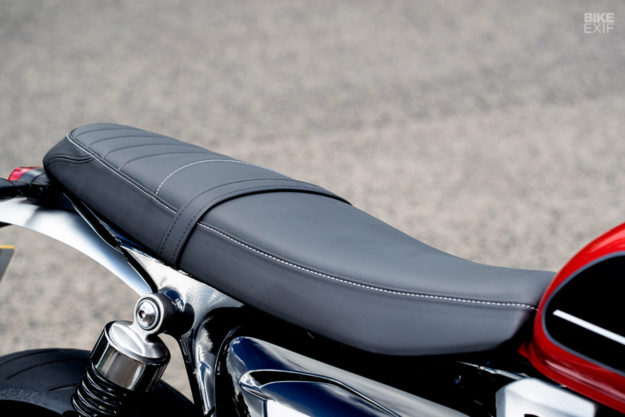
The Speed Twin comes in three colors: Jet Black, Silver Ice and Korosi Red. The silver and red versions were available at the press launch, and both paint jobs were as lush as they come.
What’s more, the graphite coach line surrounding the black graphic on each bike is painted by hand.
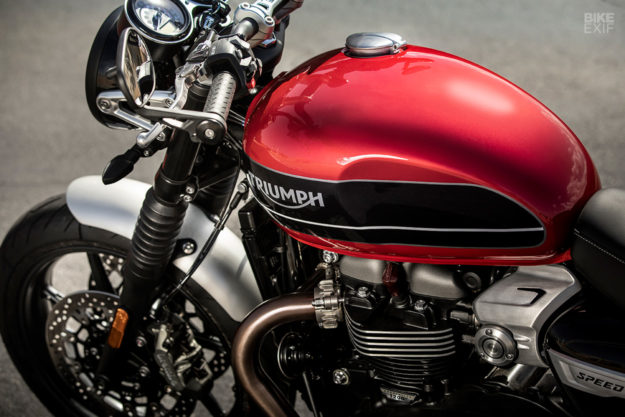
The white stripe and Triumph logo aren’t though—they’re just decals, covered by layers of clear coat.
So the Speed Twin stands out from the crowd on specs and aesthetics. But how does it ride? We took a 250 km route through Mallorca’s sprawling countryside and winding mountain roads to find out.
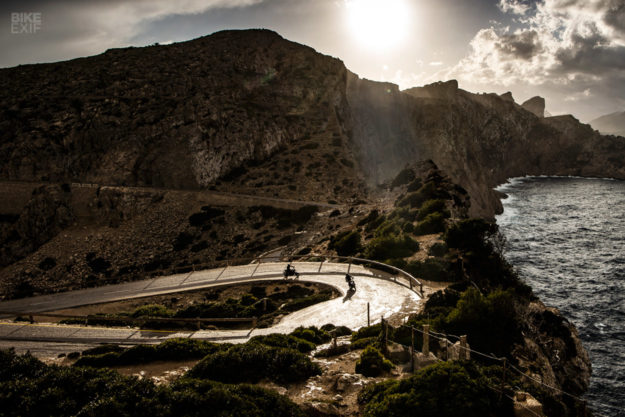
And then it rained. All day. We rode anyway, but with the rain turning the road surface from sketchy to extremely sketchy, I couldn’t really exploit the Speed Twin’s performance or handling.
I did learn that the ergonomics are pretty standout when compared to Triumph’s other twins. The pegs are 38 mm forward and 4 mm lower than the Thruxton’s, making the riding position slightly more relaxed.
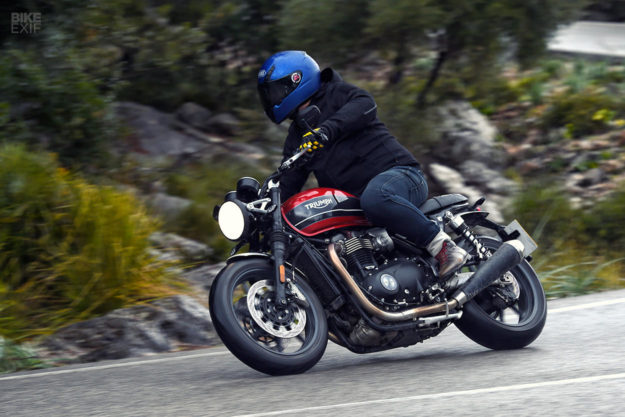
But when you combine that with the handlebars—borrowed from the Speed Triple—and the tipped-forward bench seat, it makes for a very engaging riding position. The arrangement pushes your weight forward, over the bike’s center of gravity, and almost forces you to get your elbows out and your head up.
That setup hits the mark for me, even if I did find the seat a little harsh. I wouldn’t hate a little more padding, and a bit more of a step to tuck into. (On the up side, it actually seemed to get more comfortable as the day wore on.)
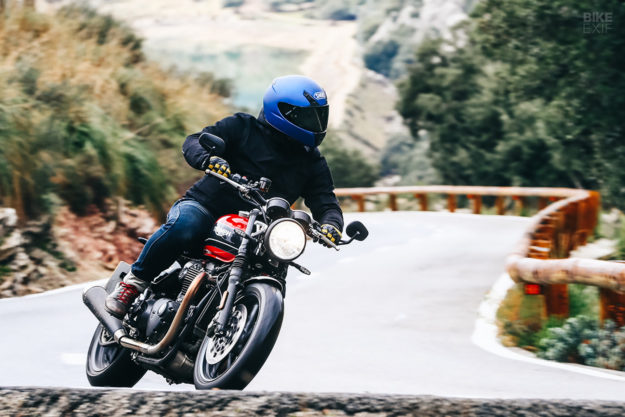
It also contributes to what is a pretty sweet handling bike. Even at a more cautious pace and with limited grip, I never had to fight the Twin to make it go where I wanted.
Triumph was right about the suspension’s capability too; it never once felt unsettled or outgunned. And when I did push a little too hard—and things started getting random—I could rein it back in.
We weren’t going as slowly as I thought, too. I was following our ex-racer lead rider, and a fearless Brazilian journalist, and our tail rider pointed out afterwards that we were hustling at a pretty respectable pace. Which is a testament to how planted the Speed Twin really is.
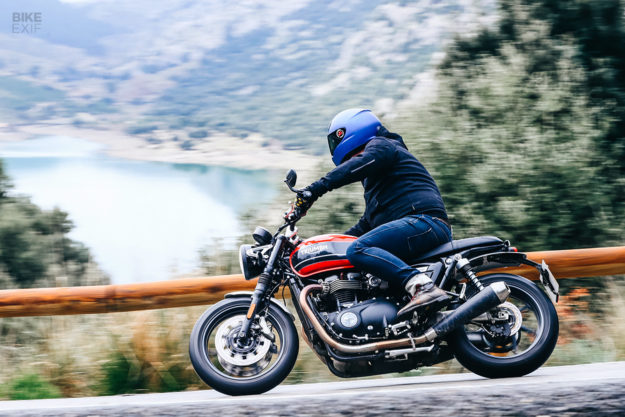
It’s also not lacking in grunt. That engine, with its 270 degree firing order, is a total peach—and even the stock cans kick out a pleasing rumble.
Granted, I spent most of the day in Rain mode, but even then I had plenty of usable power at hand, delivered evenly via the ride-by-wire throttle. And the clutch and transmission were both light enough not to tire me out.
It’s worth pointing out here that Triumph’s riding modes each feature their own mix of power delivery, traction control and anti-wheelie control. And that was abundantly clear when we eventually hit a short dry patch, and I flicked the Speed Twin right over to Sport mode.
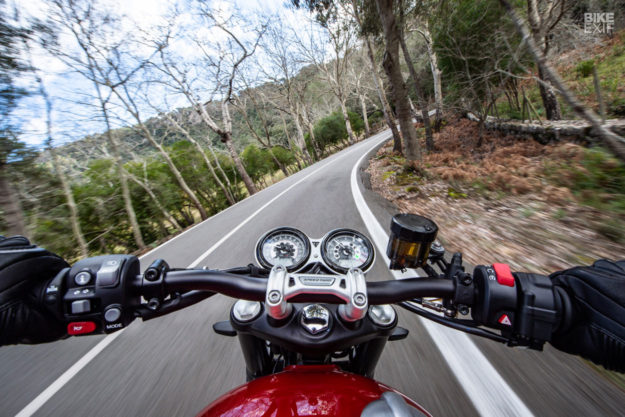
It immediately went from mellow to rowdy, with a noticeably snatch-ier throttle response, and a front wheel that wanted to lift in both first and second gear. It’s here that the Speed Twin came into its own as a performance roadster, and I’m itching to have another go at it in better weather.
Still, even under the trying circumstances, I found myself riding a bike that was composed, sharp and ultimately fun.
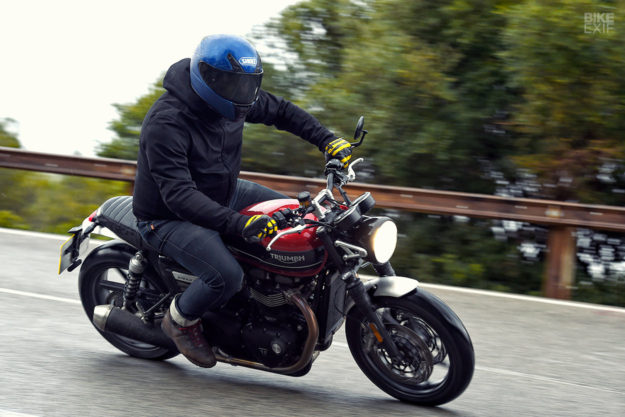
Whether you’re looking at the Speed Twin’s styling or performance, there’s no denying its charisma. So who’s it aimed at?
Triumph are gunning for their own customers as much as they are for new business. Street Twin owners might be looking to upgrade, and might prefer the Speed Twin’s performance roadster vibe to the T120’s laid-back vibe or the Thruxton’s café racer style.
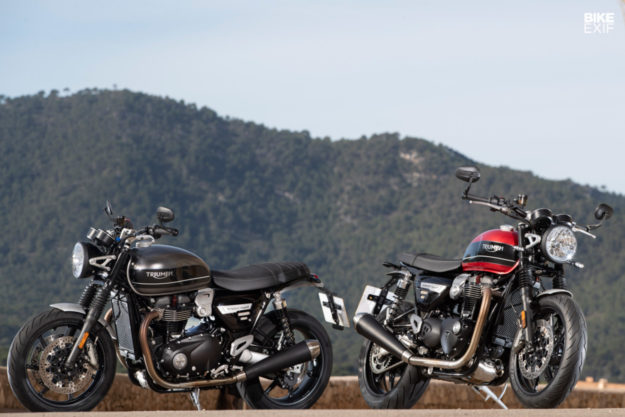
At $12,100 (black) or $12,600 (colors), the Speed Twin’s a fraction pricier than the BMW R nineT Pure ($11,995) and Kawasaki Z900RS ($11,199). And there’s not much between them on weight or performance numbers either.
So I was wrong: the Speed Twin does have a place in Triumph’s line-up: it hits the sweet spot for riders looking for yesterday’s style with today’s performance.
Myself included.
Triumph Motorcycles | Facebook | Instagram | Images by Kingdom Creative
